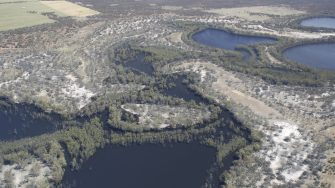
Date: Wednesday, October 20, 2021
Project: Eastern Australian Waterbird Survey
Observers: Richard Kingsford & John Porter
Pilot: James Barkell
We left Deniliquin on the Edward River early in the morning and headed south towards the River Murray. There were few waterbirds on the main channel of this river.
Then we started just east of the magnificent Barmah-Millewa Forest, a huge River Red gum Forest which is on both sides of the River Murray in Victoria and New South Wales. We flew down the main channel for most of the way until we got to the most western part of the forest where other wetland habitats such as reedbeds, lakes and lagoons are more prominent. These open areas are preferred by waterbirds.
Here we systematically went backwards and forwards surveying these prime waterbird habitats. There were very few waterbirds in the wetlands of the Barmah-Millewa forest this year. We would have been lucky to have estimated more than 100 waterbirds.
However, there were a few white ibis starting to breed as well some cormorants, breeding in some of the trees. As in previous years, feral horses are still prominent on the Victorian side of the forest. This continues to be a problem for the protected area, given the damage that horses do to wetlands.
Barmah Lake in the foreground and Moira Lake in the background in the Barmah-Millewa Forest.
From here, we then headed west to the next big wetland, the Koodrook-Pericoota river red gum forest. This doesn't have as diverse a suite of habitats, like the Barmah Millewa Forest, and so is generally much poorer for waterbirds. We surveyed very few waterbirds here.
Koondrook-Pericoota river red gum forest.
Because the river doesn’t overflow as much as it used to onto the floodplain, there is a major engineering work designed to take water from the main river to the river red gum floodplain.
Irrigation areas make for stunning circles of different hues on the River Murray.
We then headed for Swan Hill for a break and refuel the plane. After lunch, the wind got up and we headed northwest to survey the Hattah-Kulkyne lakes. This group of floodplain Lakes is predominantly supplied by pumped water from the River Murray.
Many of the lakes had water and it was clear that much of this had only just arrived. It was black from the effects of blackwater, leaking of tannins and breakdown of leaves and other organic matter. They were very few waterbirds across this system either. We again found fewer than 100 waterbirds, quite different to some years when we have surveyed this system.
New irrigation areas on the River Murray.
Once we were done on the Hattah Lakes we headed south to survey Lake Tyrell a massive saltwater lake. The salt was illusory of flooding. The hypersaline water was not suitable for waterbirds.
Flying over the highly saline Lake Tyrell.
After this, we headed south-east to the Kerang Lakes. Surprisingly many of the temporary lakes were dry, underlining how patchy the rainfall has been.
Lake Tutchewop one of the drying salt lakes.
Only the large regulated lakes in this system, like Kangaroo Lake and Lake Charm Lake had water. These lakes are kept artificially full with water.
Like many other places we have surveyed, there were relatively few waterbirds on the lakes. Generally these perennial Lakes were dominated by the fish eating birds, the pelicans, cormorants and terns.
There were a few of the temporary freshwater lakes with some flooding, but only about half full and had more than a hundred waterbirds.
Lake Bael Bael one of the freshwater lakes with water.
Lake Bael Bael.
One of the salt lakes was drying back. Its shallow water provided habitat for a few hundred red-necked avocets, banded stilts and shelduck.
One of the dry salt lakes (pink) with the freshwater Kerang Lake in the background.
The last three lakes that we surveyed in the Kerang Lakes were Third Lake, Middle Lake and Reedy Lake. Middle Lake is always an impressive water body because this is where straw-necked Ibis, white ibis and royal spoonbills often breed. And today was not disappointing. There were 5-10,000 breeding straw-necked ibis, and smaller numbers of breeding white ibis and royal spoonbills.
Breeding straw-necked ibis on Middle Lake in the Kerang Lakes.
There were more royal spoonbills breeding on Reedy Lake and a few white ibis. It's always great to see such large numbers of colonially breeding waterbirds. We headed back to Swan Hill for the night.
